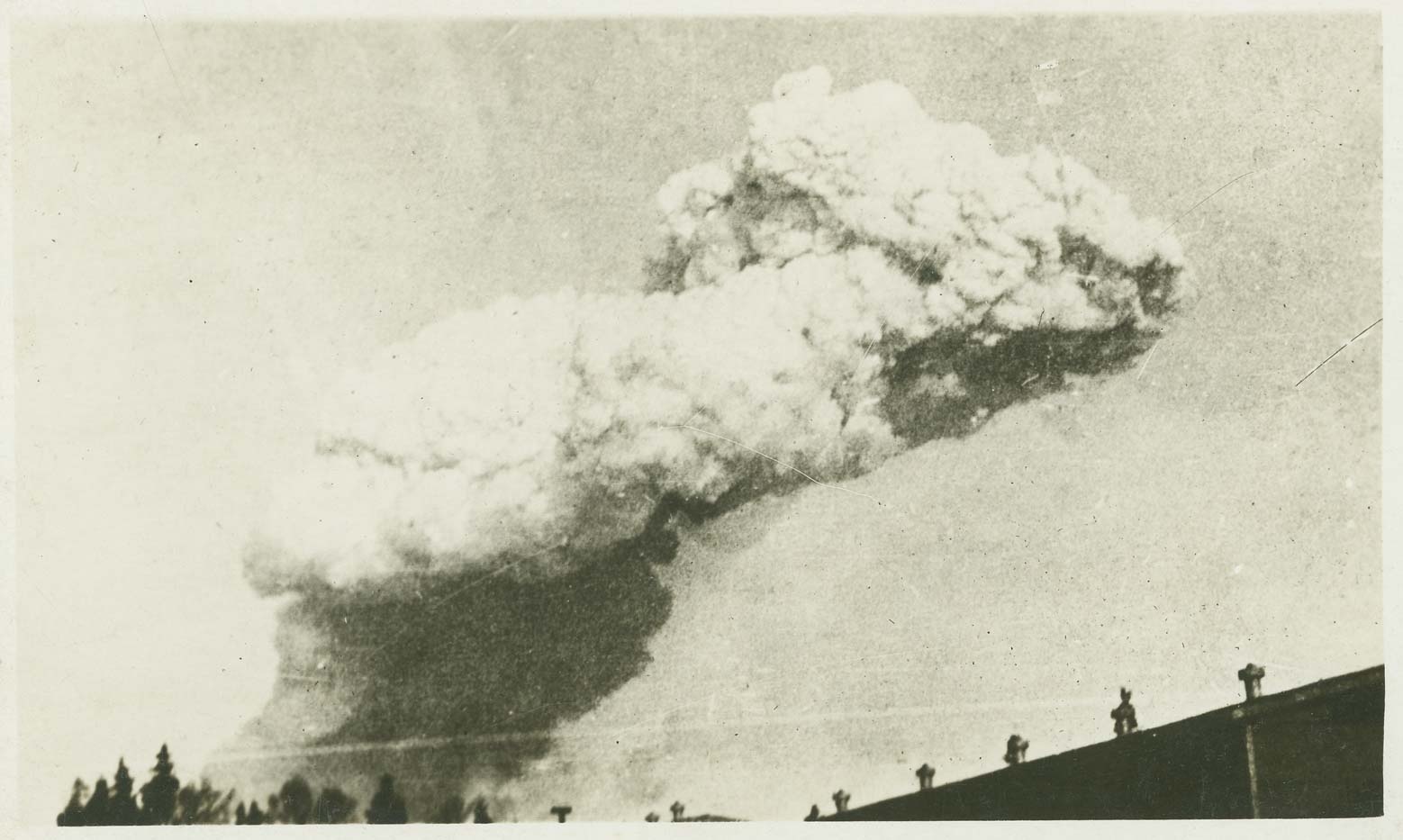How the Halifax Explosion destroyed a city and became a folk song

Smoke cloud from the Halifax Explosion, probably taken off McNabs Island. Original photograph “developed by Captain Baird.”
SUMMARY
The largest explosion in the world before the Atomic Age was the Halifax Explosion. It took place in 1917 in a harbor town of Canada. The massive, accidental blast destroyed much of Halifax, Nova Scotia, killed almost 2,000 people, and tore apart multiple vessels. Now, it's well remembered in poems, a single sailor's diary, and a popular folk song named "Fire and Flame."

The Mont-Blanc and the Imo
Canada joined World War I on August 5, 1914, automatically as a British Dominion when Great Britain entered the war. Almost 8 percent of Canadians volunteered to serve overseas, and the home front mobilized to support the nation and the British Empire.
At Nova Scotia, troops and massive amounts of war supplies moved from the docks to waiting ships. On the morning of December 6, 1917, the Norwegian supply ship Imo left the harbor filled with only ballast. It was en route to New York to pick up relief supplies for Belgians.
A local ship pilot guided the Imo toward the sea, but he struggled with multiple ship passings in the tight waters of the channel. The Imo ended up on the wrong side of the channel, like a car driving on the wrong side of the road.
That's always a risky problem for ships. But Imo found itself on the wrong side of the channel at the worst possible time. A fully loaded ammo ship, the Mont-Blanc, headed into the harbor. The Mont-Blanc sailed on the eastern side of the channel, as it normally should, but in a direct path with the Imo. It carried 2,300 tons of picric acid, 200 tons of TNT, 35 tons of high-octane gasoline, and 10 tons of gun cotton.
Typically, ships like the Mont-Blanc would have been prevented from entering the harbor unless they were unloading there, but the heavily laden ammo ship was ordered to link up with its convoy across the Atlantic from there.
A collision leads to the Halifax Explosion
The ship officers attempted to negotiate their ships past each other, but miscommunications plagued the effort. The Imo crashed into the Mont-Blanc. The cargo didn't ignite during the crash, a stroke of luck. But as the ships pulled apart from one another, sparks from the grinding metal fell on a large store of dry picric acid in the Mont-Blanc. The acid caught fire, and the fire spread to benzol on the deck. The Benzol, a type of gasoline, sent massive plumes of black smoke into the sky.
Firefighting efforts failed and the French crew abandoned ship. Crew members tried to tell residents to flee, but they only spoke French and the citizens of Nova Scotia mostly spoke English. Terribly, the smoke columns attracted attention from passing schoolchildren and thousands of residents who all stared at the burning ship for 20 minutes.
And then the Mont-Blanc exploded, sending out a massive blast wave that sent out shrapnel, shattered windows, and leveled buildings. Glass, metal, and a tidal wave of water tore through the harbor, city, and a nearby traditional fishing village.
The explosion and fallout
Most descriptions of the explosion came from witness accounts weeks or months after the event. But a family member of Frank Baker, a Canadian sailor, found a diary with 918 words written the same day as the explosion. His words describe the terrifying scene.
“We...had just drawn soap and powder and the necessary utensils for cleaning paint work,” he wrote, according to Smithsonian Magazine, “when the most awful explosion I ever heard or want to hear again occurred.”
“The first thud shook the ship from stem to stern and the second one seemed to spin us all around, landing some [crew members] under the gun carriage and others flying in all directions all over the deck,” he wrote.
Fires broke out on ships all around and hundreds of small crafts had been blown to hell and the sea presented an awful scene of debris and wreckage. Our doctor attended to the wounded men on the tug as quickly as possible and we laid them on stretchers in a motor boat and took them to hospital. The scene ashore was even worse. The N.W. part of Halifax was in total ruins and fires were springing up all over the city. Part of the railway was completely demolished and everywhere were dead and dying among the ruins. When we arrived at the hospital, the windows were all blown out and the wards were two feet deep in water owing to all the pipes having burst. We had to return to our ship as quickly as possible, as we are Guard Ship and responsible for the safety of the other vessels in harbour.”
The Imo blew onto the shore, as did other vessels. A Mi’kmaw people fishing settlement was completely washed away by the tidal wave of water propelled by the explosion.
The official death toll of the Halifax Explosion was 1,963. The incident injured another 9,000 people and left 6,000 homeless. Tragically, glass and metal shrapnel from the explosion blinded many of the bystanders watching the fire. And many schoolchildren who'd stopped to watch the fire were killed or injured.
Modern safeguards require better packing of explosive materials and deconflicting tight waterways where they pass. And chemists have made more stable, safer explosives. But those adjustments came much too late for the people of Halifax.
SHARE
